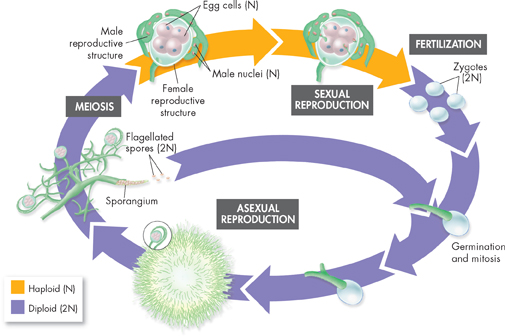The life cycle of a water mold is shown in Figure 21–7. Water molds grow into long branching filaments consisting of many cells formed by mitotic cell division. Water molds—and many other protists—reproduce asexually by producing spores in a structure called a sporangium (spoh RAN jee um). In water molds the spores are flagellated. Water molds also reproduce sexually by undergoing meiosis and forming male and female structures. These structures produce haploid nuclei that fuse during fertilization, forming a zygote that begins a new life cycle.
21.2 Assessment

-
Review Summarize three ways in which protists move.
Compare and Contrast How is movement by means of flagella different from movement by means of cilia?
-
Review Describe how protists reproduce.
Explain How does conjugation produce genetic diversity in a population of Paramecium?
Compare and Contrast How does a macronucleus differ in function from a micronucleus?

Apply the Big idea
Compare asexual and sexual processes in paramecia. Include the terms mitosis and meiosis in your answer. You may want to refer back to Chapters 10 and 11 to review mitosis and meiosis.
Table of Contents
- Formulas and Equations
- Applying Formulas and Equations
- Mean, Median, and Mode
- Estimation
- Using Measurements in Calculations
- Effects of Measurement Errors
- Accuracy
- Precision
- Comparing Accuracy and Precision
- Significant Figures
- Calculating With Significant Figures
- Scientific Notation
- Calculating With Scientific Notation
- Dimensional Analysis
- Applying Dimensional Analysis





